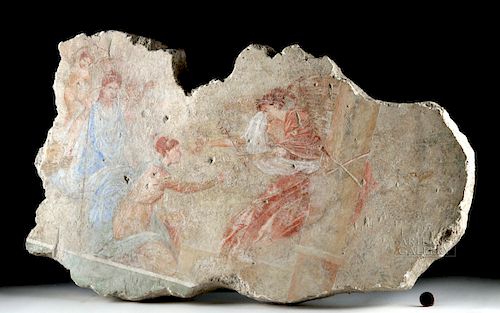Roman Fresco Fragment - Annunciation Scene
Lot 48
About Seller
Artemis Fine Arts
686 S Taylor Ave, Ste 106
Louisville, CO 80027
United States
Selling antiquities, ancient and ethnographic art online since 1993, Artemis Gallery specializes in Classical Antiquities (Egyptian, Greek, Roman, Near Eastern), Asian, Pre-Columbian, African / Tribal / Oceanographic art. Our extensive inventory includes pottery, stone, metal, wood, glass and textil...Read more
Estimate:
$35,000 - $45,000
Absentee vs Live bid
Two ways to bid:
- Leave a max absentee bid and the platform will bid on your behalf up to your maximum bid during the live auction.
- Bid live during the auction and your bids will be submitted real-time to the auctioneer.
Bid Increments
| Price | Bid Increment |
|---|---|
| $0 | $25 |
| $300 | $50 |
| $1,000 | $100 |
| $2,000 | $250 |
| $5,000 | $500 |
| $10,000 | $1,000 |
| $20,000 | $2,500 |
| $50,000 | $5,000 |
| $100,000 | $10,000 |
| $200,000 | $20,000 |
About Auction
By Artemis Fine Arts
Feb 21, 2019
Set Reminder
2019-02-21 10:00:00
2019-02-21 10:00:00
America/New_York
Bidsquare
Bidsquare : Exceptional Antiquities, Asian, Ethnographic
https://www.bidsquare.com/auctions/artemis-gallery/exceptional-antiquities-asian-ethnographic-3858
An important one-day auction featuring museum-worthy examples of Egyptian, Greek, Roman, Etruscan, Near Eastern, Far East / Asian, Pre-Columbian, African / Tribal, Oceanic, Native American, Spanish Colonial, Russian, Fossils, Ancient Jewelry, Fine Art, so much more! Artemis Fine Arts info@artemisfinearts.com
An important one-day auction featuring museum-worthy examples of Egyptian, Greek, Roman, Etruscan, Near Eastern, Far East / Asian, Pre-Columbian, African / Tribal, Oceanic, Native American, Spanish Colonial, Russian, Fossils, Ancient Jewelry, Fine Art, so much more! Artemis Fine Arts info@artemisfinearts.com
- Lot Description
Roman, ca. 1st century BCE. An important fresco depicting 5 figures in an architectural setting. Alighting from the right, the winged goddess Victory (Greek Nike) gestures to a kneeling orant. Donning a laurel wreath in her coiffure, a russet red garment with folds of drapery skillfully delineated, and a contrasting white sash billowing across her body, she holds a caduceus in her left hand and a wreath in her right as the supplicant, with an upswept curly coiffure adorned by a band and wearing a chiton with a green himation flowing around her neck and legs, reaches for it. Venus (Greek Aphrodite) sits to the left with a pair of playful Cupids behind. Meanwhile, Venus, goddess of love and beauty, dons a sky blue himation over a periwinkle blue peplos, and a gold diadem adorns her flowing locks. A classical column occupies the right foreground, a white dove hovers to the right, and a white groundline underscores the scene. Note: some have suggested that this composition may prefigure Christian Annunciation iconography. Size: 23" W x 14" H (58.4 cm x 35.6 cm)
The ancient fresco technique involved applying saturated pigments into wet lime-rich plaster, and only the wealthiest, most elite Romans adorned their houses with these elaborate wall paintings which required immense skill to create. Art historians have identified four styles of wall painting. This example aligns closest with the Second Pompeiian Style - also known as the architectural style - which was popular during the 1st century BCE. This style was characterized by illusionism whereby the walls were painted with architectural elements framing compositions that fooled the eye into believing they were real via a trompe l'oeil effects. The column in this example was a widely embraced device used by the Romans to divide the wall space into zones and convince viewers of three-dimensional imagery by pushing the picture plane further back from the wall. The artist of this piece also successfully achieved naturalism in the visual imagery via subtle tonal changes, modeling the figures with color and shading, and suggesting depth with foreshortening.
Another aspect of Roman wall painting to appreciate are the brilliant colors which contrast with the white hues of surviving ancient marble sculpture. Scholars have demonstrated that classical sculptures were actually originally brightly painted; however, the pigments have worn away over the ages. Thankfully, ancient wall paintings demonstrate the bold coloration that embellished ancient visual culture. What's more while some of the most impressive artists of the Classical world were painters, sadly, many of their creations were painted on wood panels and have disappeared due to the perishable nature of this material. Thankfully, other forms of Classical art such as vase paintings, mosaics, and even a few fresco fragments like this example - many surviving from Pompeii and Herculaneum buried under the ash of a volcanic eruption in the year 79 CE - have survived the tests of time and can provide a means of understanding ancient painting techniques.
Provenance: ex-private Chicago, Illinois, USA collection; acquired from the Merrin Gallery, New York, August 31, 1989
All items legal to buy/sell under U.S. Statute covering cultural patrimony Code 2600, CHAPTER 14, and are guaranteed to be as described or your money back.
A Certificate of Authenticity will accompany all winning bids.
We ship worldwide and handle all shipping in-house for your convenience.
#141808Repaired from several fragments with minor fill in the breaks and in the losses. Expected surface wear with pigment loss, minor chips, and cracks commensurate with age. Edges are not smooth. Black felt and suspension hooks on verso.Condition
- Shipping Info
-
All shipping is handled in-house for your convenience. Your invoice from Artemis Gallery will include shipping calculation instructions. If in doubt, please inquire BEFORE bidding for estimated shipping costs for individual items.
-
- Buyer's Premium



 EUR
EUR CAD
CAD AUD
AUD GBP
GBP MXN
MXN HKD
HKD CNY
CNY MYR
MYR SEK
SEK SGD
SGD CHF
CHF THB
THB















